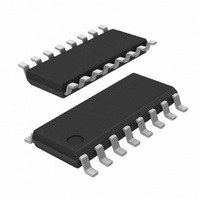SI2400-KS Silicon Laboratories Inc, SI2400-KS Datasheet - Page 27

SI2400-KS
Manufacturer Part Number
SI2400-KS
Description
IC ISOMODEM SYSTEM-SIDE 16SOIC
Manufacturer
Silicon Laboratories Inc
Type
Integrated Global DAAr
Datasheet
1.SI3015-F-FS.pdf
(94 pages)
Specifications of SI2400-KS
Package / Case
16-SOIC (3.9mm Width)
Data Format
V.21, V.22, V.23, Bell 103, Bell 212A
Baud Rates
2.4k
Interface
UART
Voltage - Supply
3 V ~ 5.25 V
Mounting Type
Surface Mount
Product
Modem Chip
Supply Voltage (min)
3 V
Supply Current
21 mA
Maximum Operating Temperature
+ 85 C
Minimum Operating Temperature
- 40 C
Mounting Style
SMD/SMT
Lead Free Status / RoHS Status
Contains lead / RoHS non-compliant
For Use With
336-1166 - BOARD EVAL FOR SI2400 ISOMODEM
Lead Free Status / RoHS Status
Lead free / RoHS Compliant, Contains lead / RoHS non-compliant
Other names
336-1093
Available stocks
Company
Part Number
Manufacturer
Quantity
Price
Part Number:
SI2400-KS
Manufacturer:
SILICON LABS/芯科
Quantity:
20 000
Part Number:
SI2400-KSR
Manufacturer:
SI
Quantity:
20 000
3. When the next frame of data is detected, EOFR is lowered
To summarize, the host will begin receiving data
asynchronously from the Si2400. When each byte is
received, the host should check the EOFR pin (or the
ninth bit). If the EOFR pin (or the ninth bit) is low, then
the data is valid frame data. If the EOFR pin (or the
ninth bit) is high, then the data is a frame result word.
(or bit 9)
checksum does not match, the Si2400 echoes “e” (error).
Additionally, if the Si2400 detects an abort (seven or more
contiguous ones), then it will echo an “A”.
When the “G”, “e”, or “A” (referred to as a frame result
word) is sent, the Si2400 raises the EOFR (end of frame
receive) pin (see Figure 10B). The GPIO1 pin must be
configured as EOFR by setting SE4[3] (GPE) =
addition to using the EOFR pin to indicate that the byte is a
frame result word, if in 9-bit data mode (set S15[0] (NBE) =
1
word. To program this mode, set S0C[3] (9BF) =
SE0[3] (ND) =
and the process repeats at step 1.
EO FR
RXD
CTS
b
TXD
), the ninth bit will be raised if the byte is a frame result
Si2400 ready for byte 1 of frame N
Start
1
Host begins frame N
Note: Figure not to scale.
b
.
Receive Data
Start
Stop
(CTS used as normal flow control.)
Start
Frame N
Figure 11. HDLC Timing
CRC Byte 1
A. Fram e Transm it
1
B. Fram e Receive
1
b
b
. In
and
Rev. 1.3
Stop
5.15. Fast Connect
In modem applications that require fast connection
times, it is possible to reduce the length of the
handshake.
If the Si2400 is set up as an answering modem, the
answer tone transmitted by the Si2400 may be
shortened by setting S1E (TATL) = 0x00 and setting
S34 (TASL) to the desired answer tone length. For the
most robust operation, it is recommended that the
answer tone sent by the answering modem be at least
10 msec (S34 (TASL) = 0x06).
If the Si2400 is configured as an originating modem,
setting the No Answer Tone bit (S33[1] [NAT] = 1
forces the Si2400 to recognize a short answer tone,
thereby reducing the overall connection sequence.
Additional modem handshaking control can be adjusted
through the registers shown in Table 15. These
registers are most useful if the user has control of both
the originating and answer modems.
Host finished sending frame N
Start
Stop
Si2400 detects end of frame N.
CRC Byte 2
Si2400 ready for byte 1
of frame N + 1.
Stop
Host begins frame N + 1
Start
Start
Frame Result W ord
Si2400
Frame N + 1
Stop
27
b
)













